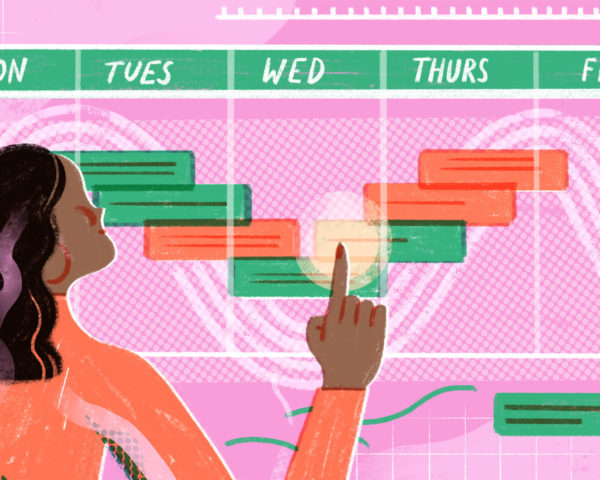At the end of a project or sprint, it’s time for your retrospective. Whether you do it in person or remotely, this meeting is a chance for your team to talk about what went well, what didn’t go so well, and how you’ll get better.
When it’s done right, your retrospective should lead to deep reflection, meaty discussions, and actionable takeaways. But to get there, you need to do more than ask, “So, how’d it go?”
Retrospective techniques give you and your team a framework to use as you look back and learn. Here are nine of our favorite exercises to squeeze the most value out of your retrospective meetings.
1. Significant events
Particularly if you’re looking back on a longer sprint or a bigger project, it helps to refresh the team on what happened and when. That’s what this technique is for — it orients your team with a simple timeline.
On a whiteboard (use a virtual whiteboard if you’re doing a remote retrospective), draw a horizontal line across the whole thing. This is your timeline. Ask team members to mark releases, big wins, big fails, changes to team membership, or anything else that was significant to your team.
This exercise only takes 10 or 15 minutes and helps everybody move into the rest of the retrospective with brushed-up context and knowledge.
2. Start, stop, continue
If your team gets a little twitchy at the thought of talking about how they feel, ease them into it by focusing on what they’ll do. The format is action-oriented and simple: you talk about what you need to start doing, what you should stop doing, and what you should continue doing.
If you use this format for the entire retrospective, spend 10 minutes each on start, stop, and continue. For longer retro sessions, you can also use it lightning-round style at the end as you’re identifying action items and owners.
3. Like, loathed, lacked, learned
Much like “start, stop, continue,” this technique is pretty self-explanatory. You and your team will discuss what you liked about the project or sprint, what you loathed, what you lacked (or longed for), and, most importantly, what you learned.
Allow 10 minutes for each question. As a bonus, this “4Ls” retrospective technique is great for personal retrospectives as well, whether you want to reflect on your entire year, your previous performance period, or anything else.
4. Mad, sad, glad
Unlike many of the other retrospective techniques, this one is focused on how the work made your team feel.
Your team will look back and share what made them feel irritated or angry, what made them feel disappointed, and what made them feel happy. It’s not a woo-woo exercise — it helps your team put its finger on what you should do more of and what’s causing unnecessary friction and frustration.
5. Five whys
If and when you and your team identify a painful or problematic moment that you’d like to avoid in the future, it’s worth digging into why that failure happened.
The 5 whys analysis pushes your team to find the root cause of a problem by asking “why?” five times. For example, if the team is frustrated that all the tasks couldn’t be completed during a sprint, you’d ask:
- Why? We didn’t have enough time.
- Why? The mockups took way longer than anticipated.
- Why? The marketing team was slow to get us the copy we needed.
- Why? They had other pressing priorities ahead of our project.
- Why? We didn’t give them an early enough heads-up about the work.
When you don’t dig deep enough, you risk addressing a surface-level symptom — like extending future sprints or reducing your tasks. But in reality, other steps (like refining a work request and scheduling system when working with other teams) offer better and longer-term solutions.
6. Sailboat
This retrospective technique demands a little imagination from your whole team. Just as the name implies, you’ll think of your last project or sprint as a sailboat. Using that metaphor, you’ll work together to identify the:
- Rocks: What risks, challenges, and obstacles did you face?
- Anchors: What problems held you back and caused bottlenecks?
- Wind: What helped push the team forward?
- Land: What is your ultimate goal or vision for the next sprint or project?
Try using a sailboat retrospective template to help your team visualize their work and bring this technique to life.
7. What, so what, now what
Retrospectives don’t just look at what happened — they determine what you’ll do next. This technique offers a simple framework that keeps your team future-focused.
Using this technique, you and your team will pinpoint something that happened during your last sprint or project (what?), talk about the impact or consequences of that event (so what?), and figure out what next steps you’ll take (now what?).
8. Energy levels
There’s work that makes you feel energized and enthusiastic – and there’s work that makes you feel completely drained and depleted. With this retrospective technique, your team will parse the work that charged them up from the work that sapped them of energy.
You can think of your team almost like a battery, answering questions in the following categories:
- Fully charged: What made you feel energized?
- Low battery: What drained your energy, enthusiasm, or motivation?
- Upcoming energy: What is your energy level for the next sprint?
While you’re at it, it’s worth talking through some changes or action times that will help the whole team head into the next sprint feeling totally recharged.
9. Dot voting
At the end of a well-run retrospective, you and your team will likely have a pile of ideas about how to improve your next sprint or project. That can be equal parts exciting and overwhelming.
Dot voting gives your team clearer direction about what improvements you’ll prioritize. List them on your virtual whiteboard or other collaborative space. Then, have everyone place a dot, emoji, or other symbol on the three ideas they’d like to see at the top of the list.
When everybody has cast their votes, discuss the results and prompt your team with questions like, “Why is that idea more valuable than the others?” and “What would happen if we didn’t do that?” When you have your three winning ideas, select owners and due dates for the top-voted items.
⚠️ If the same ideas and issues are top-voted retro after retro, you may only be treating the symptom. Go back to the “5 whys” technique to unearth the root cause.
Pro Tip
Before you kick off your next sprint, host a pre-mortem. During this conversation, you and your team will think about what could happen – both good and bad – during your sprint and make a plan with that in mind. The things you learn from your retrospectives will be helpful as you hash out your next steps.
4 retrospective best practices to make the most of your meeting
The above techniques will help your team have a more structured and productive conversation. But, as you work through them, there are a few other retrospective tips and best practices to keep in mind.
1. Start with an icebreaker
A retrospective can feel a lot like you’re giving your sprint a performance review, and that can be nerve-wracking for some people. Starting with a fun and lighthearted icebreaker game gives the team a chance to loosen up and bond before they get into the meat of the meeting.
Think you can’t do icebreakers remotely? Think again. There are plenty of challenges, activities, and prompts that are perfect for distributed teams.
2. Speak like a human
It’s much easier to talk about project mechanics than relationships and communication. But many issues that have nothing to do with tasks and everything to do with human interactions. In those cases, the real conversation to be had is not in project language, but in people language.

Reserve a portion of your retrospective to discuss the interpersonal stuff. What are people’s assumptions and expectations? Where are the misunderstandings? How do people feel about their work? Why are the same improvement actions coming up again and again?
3. Ask for highlights
Your team is a cohesive unit, but it’s important to remember that individual team members might have unique experiences or feelings about each sprint.
If time allows (and team members are willing), have each participant share what strikes them as the most important thing the team discussed during the retrospective and explain why it stands out to them. It ensures everybody gets a chance to contribute and promotes deeper discussion.
4. Offer praise and kudos
When you’re busy getting $#!τ done, it’s easy to let good deeds go unnoticed and unacknowledged. Leave five minutes at the end for peer-to-peer kudos — even for little things like giving helpful feedback or being a sounding board.
By this point in the retro, you’ve probably had some intense (perhaps uncomfortable) discussions, so use this technique to close the session on a high note.
Continuous improvement for the win
Don’t let your retrospectives become stale – or worse, devolve into glorified catch-up sessions. Try multiple different retrospective techniques to keep your team engaged and your conversations fresh.
Keep in mind there are other ways to change up your retros too. Have a different team member lead each one, include people from adjacent teams if they were deeply involved in the work, or switch up your cadence.
Retros are all about continuous improvement, and that applies to the actual format of your meeting too. Keep experimenting, keep improving, and keep winning.
Special thanks to Kat Boogaard for her contributions to this article.












































